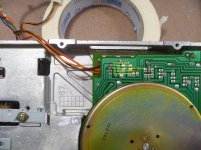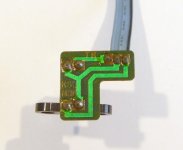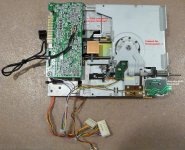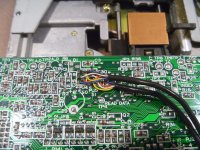A4000Bear
Experienced Member
I was recently given a rather bruised and battered C128DCR, which was missing its floppy drive. It also came with a 1571 drive. After restoring the C128, I decided to transfer the drive mechanism from the 1571 into the C128DCR, to make a complete unit.
Unfortunately the drive didn't work. It didn't take me long to find out about the Newtronics D502 drives and their notoriously bad heads. Sure enough, the drive in my 1571 had open circuit heads. After reading numerous blog and forum posts, I decided that trying to find a replacement drive is probably not a good idea given how unreliable they are. So I decided to try hacking a different drive to make it suitable for the C128 and 1571.
I'm pleased to say I have been successful, and my C128 now has a functional drive.
The drive I used was a Chinon FZ-502. The reason why I chose it was simple. I have two spare ones, so I can easily modify the second one for my 1571.
The modification is reasonably straightforward. I removed the old connectors and wires from the Newtronics D502 and connected them to the appropriate places on the stepper motor, spindle motor drive board, and R/W heads. If there is interest in this modification, I'll document it and post it here.
The only problems I had was that the latch was in a different place compared to the original. I had to fill the original hole in the C128 front panel, and drill a new one. My front panel was already full of holes which I had to patch and paint anyway, so it wasn't really a problem for me. Additionally, part of a metal plate on the front of the drive had to be cut away as if fouled the back of the front panel.
Here is a pic of the drive in my C128.
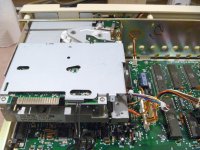
Unfortunately the drive didn't work. It didn't take me long to find out about the Newtronics D502 drives and their notoriously bad heads. Sure enough, the drive in my 1571 had open circuit heads. After reading numerous blog and forum posts, I decided that trying to find a replacement drive is probably not a good idea given how unreliable they are. So I decided to try hacking a different drive to make it suitable for the C128 and 1571.
I'm pleased to say I have been successful, and my C128 now has a functional drive.
The drive I used was a Chinon FZ-502. The reason why I chose it was simple. I have two spare ones, so I can easily modify the second one for my 1571.
The modification is reasonably straightforward. I removed the old connectors and wires from the Newtronics D502 and connected them to the appropriate places on the stepper motor, spindle motor drive board, and R/W heads. If there is interest in this modification, I'll document it and post it here.
The only problems I had was that the latch was in a different place compared to the original. I had to fill the original hole in the C128 front panel, and drill a new one. My front panel was already full of holes which I had to patch and paint anyway, so it wasn't really a problem for me. Additionally, part of a metal plate on the front of the drive had to be cut away as if fouled the back of the front panel.
Here is a pic of the drive in my C128.



